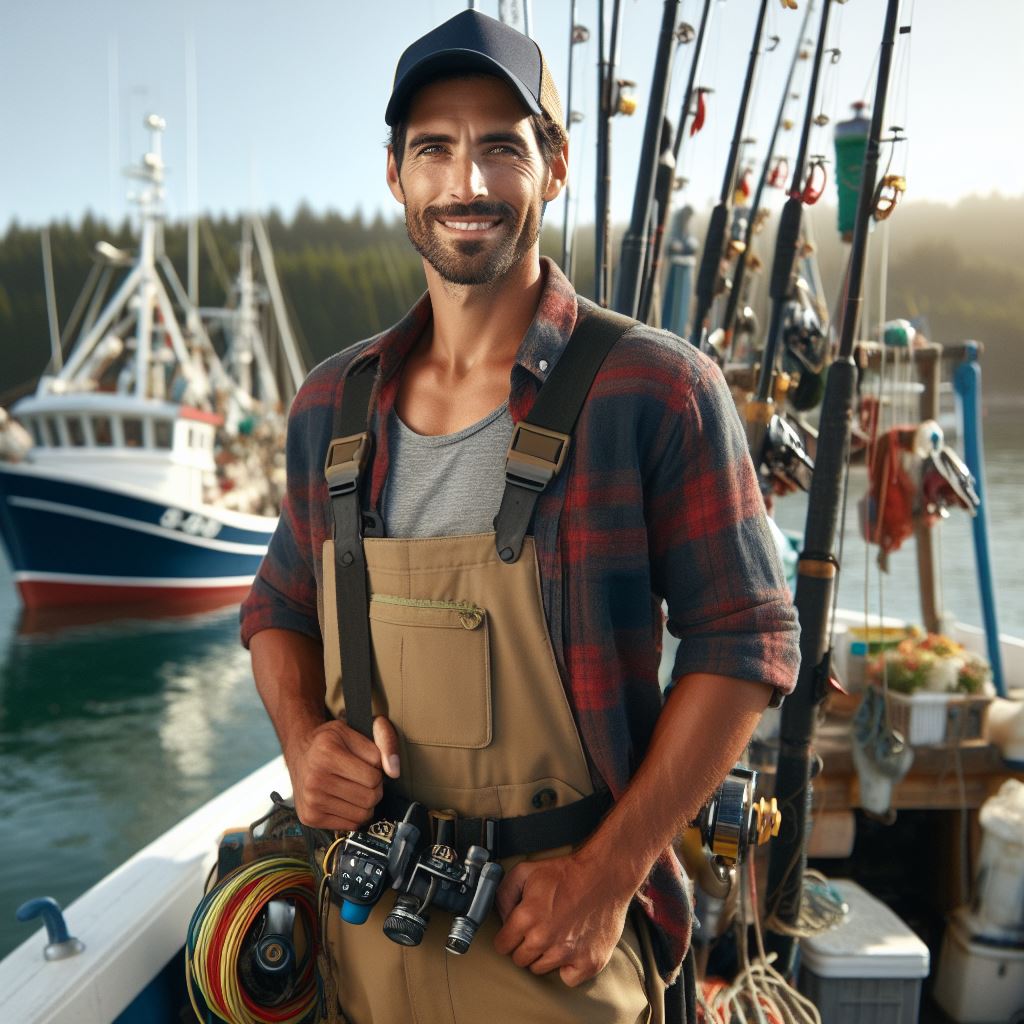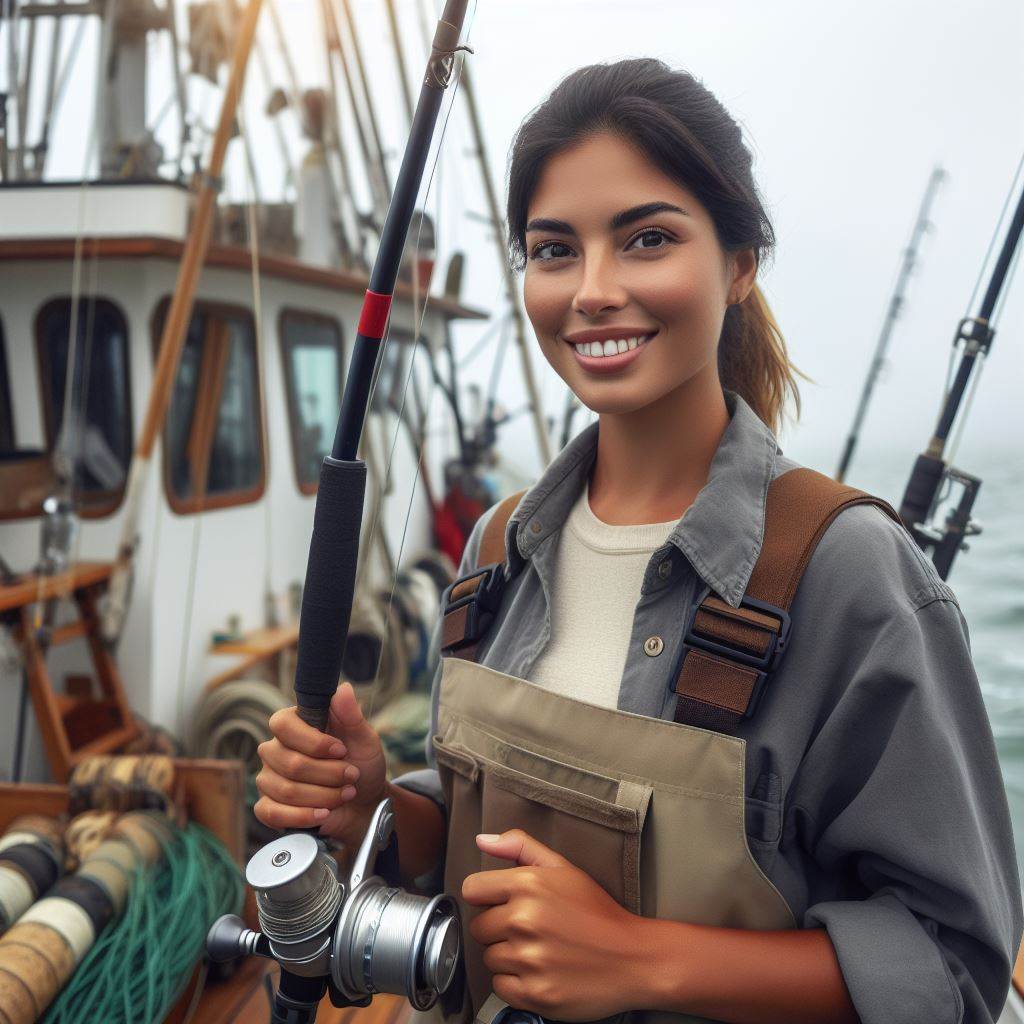Introduction
A. Brief overview of the fishing industry in New Zealand
New Zealand’s fishing industry plays a crucial role in the country’s economy and culture.
Fishing is deeply woven into the fabric of Kiwi life, providing both livelihood and recreational opportunities for many.
Fisheries in New Zealand have a rich history, dating back to the indigenous Maori people who relied on the sea for sustenance.
Today, the industry has evolved into a sophisticated sector, contributing significantly to the nation’s GDP.
Fishermen in New Zealand have access to bountiful marine resources, including the abundant waters of the Pacific Ocean.
They face the challenging task of navigating unpredictable weather conditions and vast stretches of open sea to catch various species, such as snapper, hoki, and tuna.
B. Importance of fishing to the country’s economy and culture
A day in the life of a Kiwi fisherman starts in the early hours of the morning as they set sail from the harbors, ready to cast their nets or lines.
Their boats are equipped with specialized equipment, such as fishfinders and winches, to locate and haul in their catch efficiently.
As the day progresses, the fisherman carefully handle each fish, ensuring they are preserved in ice to maintain freshness.
Some fishermen even specialize in certain fishing techniques, such as longlining or trawling, honing their skills to maximize their productivity.
Once the fisherman return to shore, their harvest is sent to local fish markets or processing plants for distribution across the country or exportation to international markets.
Fish is a staple part of the Kiwi diet, and the industry ensures a steady supply of fresh seafood for domestic consumption.
Additionally, recreational fishing is a beloved pastime in New Zealand, attracting locals and tourists alike.
People flock to rivers, lakes, and coastal areas to enjoy the thrill of catching their dinner or simply to relax and unwind in nature.
In essence, the fishing industry holds immense importance in New Zealand, not just economically but also culturally.
Personalized Career Consulting
Unlock your potential with expert career advice tailored to your goals. Get personalized guidance and actionable steps toward your dream career in New Zealand.
Get StartedIt sustains livelihoods, provides delicious seafood, and offers recreational opportunities, making it an integral part of Kiwi life.
Early Morning Routine
A. Waking up before sunrise
As a kiwi fisherman, my day starts long before the sun makes its appearance on the horizon.
The early morning routine is an essential part of my life, setting the tone for a productive day ahead.
Before the crack of dawn, I force myself out of bed, knowing that the ocean is calling.
The anticipation of a fruitful day in the open waters fills me with excitement each morning.
Once I am up, I quickly gather my wits and head straight to the kitchen to fuel up my body for the physically demanding day ahead.
A hearty breakfast is a must for a kiwi fisherman.
After replenishing my energy, I grab my trusted fishing gear and equipment.
This includes sturdy rods, sharp hooks, and a variety of lures carefully chosen depending on the type of fish I hope to catch.
B. Preparing fishing gear and equipment
Checking my equipment for any signs of wear or damage is vital.
Losing a prized catch due to faulty gear is a fisherman’s worst nightmare, so I meticulously inspect each item before heading out.
With everything in order, I make my way towards the coastline or the boat, depending on my planned fishing spot for the day.
Kiwi fishermen are blessed with stunning coastal scenery and abundant marine life.
The walk to the shoreline is peaceful, with only the sound of gentle waves crashing against the rocks to accompany my thoughts.
Transform Your Career with a Professional CV and Cover Letter
Stand out to employers with an ATS-optimized resume and tailored cover letter designed to match your dream role. Let us craft your job application materials for success!
Get StartedIt’s a chance for me to appreciate the natural beauty that surrounds me.
C. Heading to the coastline or the boat
Arriving at my chosen fishing spot, I carefully select the perfect location to cast my line.
Knowledge and experience play a crucial role in identifying the places where fish are most likely to gather.
As the sun slowly peeks above the horizon, painting the sky with vibrant hues, I cast my line into the water.
Patience becomes my greatest companion as I wait for that telltale tug on my bait.
The hours pass by, sometimes with little success, but the thrill of the chase keeps me going.
The serenity of being alone with nature rejuvenates my soul, erasing any frustrations along the way.
When the day begins to wane, and the sun starts its descent, I pack up my gear and reflect on the day’s adventures.
Some days are bountiful, while others test my patience, but every day is a gift.
Heading back home, tired but content, I carry with me the memories of the sea, the smell of salt in the air, and the hope of future encounters with the ocean’s abundant treasures.
A day in the life of a kiwi fisherman is not just about catching fish; it’s a celebration of nature’s beauty and the indescribable connection between man and the sea.
Read: Sustainable Fishing: NZ’s Practices Explored
On the Boat: A Day in the Life of a Kiwi Fisherman
A. Introduction to the Captain and Crew
As the sun rises, the Kiwi fisherman step onto the boat, eager for another day at sea.
Captain Tom, a seasoned sailor with weathered hands, greets the crew with a warm smile.
Boost Your Career with a Standout LinkedIn Profile
Attract recruiters and expand your network with a fully optimized LinkedIn profile tailored to highlight your strengths and professional goals. Let your profile open doors to new opportunities!
Get OptimizedThe crew, a tight-knit group of individuals from various backgrounds, prepares for the day’s challenges.
B. Review of Daily Goals and Plans
Captain Tom gathers the crew around, discussing the day’s goals and plans.
They review weather forecasts and decide to head further out to find the best fishing spot.
Each crew member knows their role and responsibility, ready to give their best.
C. Setting Sail and Navigating the Waters
With the goals set, the crew starts the engine, and the boat sets sail.
The engine’s roar fills the air as they navigate the waters, leaving the harbor behind.
Captain Tom skillfully maneuvers the boat, guiding it towards the open ocean.
The crew takes positions, adjusting sails and ensuring everything is in working order.
The salty sea breeze fills their lungs as they eagerly anticipate the day’s catch.
Seagulls gracefully glide above, a sign that fish are not too far away.
They reach the fishing spot, and Captain Tom instructs the crew to prepare the nets.
The boat slows down, and the crew works together, lowering the nets into the deep waters.
Everyone’s focus is intense, knowing their teamwork will determine their success.
The wait begins, and anticipation builds aboard the boat. The crew shares stories and laughter to pass the time.
Suddenly, a tug on the nets breaks the silence, sending excitement through the crew.
They pull the nets up, revealing a bountiful catch – snappers, herrings, and even a few kingfish.
The crew works swiftly, sorting and storing the fish in ice-filled bins, ensuring their freshness.
Captain Tom oversees the process, a proud smile on his face, knowing they will provide for many.
Their hard work pays off as they secure the catch, ready to head back to the harbor.
D. The journey back
On the journey back, the crew rests but remains vigilant, keeping an eye out for any obstacles.
The camaraderie among them strengthens as they share meals and stories of past adventures.
The sea, vast and ever-changing, reminds them of their humble existence amidst nature’s grandeur.
As the boat nears the harbor, the crew readies themselves for unloading the day’s catch.
They are greeted by eager buyers, their eyes glimmering at the sight of the fresh fish.
The hard work and dedication of the Kiwi fishermen are appreciated and duly rewarded.
As the day comes to an end, the crew disembarks with satisfaction and exhaustion.
They bid farewell to Captain Tom and each other, grateful for another successful day.
The life of a Kiwi fisherman is demanding, but it is an adventure filled with joy, challenges, and a profound connection to the sea.
Read: Fishermen in NZ: Roles, Risks, and Rewards
Casting the Nets
A. Fishing techniques used (e.g., trawling, longlining)
Fishing is not just a way of life for us Kiwi fishermen; it is a passion that runs deep in our veins.
Every day, as the sun peeks above the horizon, we set sail on our trusty boats, ready to face the challenges of the open sea.
Fishing techniques vary depending on the type of fish we seek.
Trawling is one method we employ, where a large net is dragged behind the boat, capturing fish in its embrace.
The net is then hauled back onto the boat, filled with a bountiful catch.
Another technique we use is longlining. This involves attaching a main line to which multiple baited hooks are attached at regular intervals.
The line is then cast into the water, allowing us to catch various species of fish, including snapper, tuna, and even sharks.
B. Casting the nets and catching fish
Casting the nets is an art mastered through years of experience.
We carefully calculate the weight and size of the net to ensure it captures the right amount of fish without causing harm to the ecosystem.
As the net plunges into the water, we hold our breath, hoping for a successful catch.
The ocean is where our livelihood thrives. It provides us with sustenance and income, but it is also our duty to protect its delicate balance.
That is why sustainable fishing practices are crucial to our way of life.
We believe in taking only what we need, allowing fish populations to replenish and thrive.
C. Importance of sustainable fishing practices
Sustainability means adhering to strict quotas, respecting closed seasons, and supporting initiatives to reduce bycatch.
By carefully managing our resources, we ensure that future generations of Kiwi fishermen can continue to cast their nets and earn a living.
In addition to sustainable fishing, we have embraced modern technology to aid our practice.
We utilize sonar systems to locate schools of fish, reducing the time spent searching and maximizing our catch.
GPS navigation allows us to chart our course accurately, avoiding areas where fish stocks are low.
However, our reliance on technology does not replace the ancient wisdom passed down through generations of fishermen.
We still read the signs of nature, observing bird behavior or the variation of ocean currents, to determine where the fish are actively feeding.
Casting the nets is not just about catching fish; it is about being in harmony with nature.
Our connection to the ocean runs deep, and every day we are reminded of its power and beauty.
As the sun sets on another successful day at sea, we return to shore, grateful for the bounty the ocean has provided.
Being a Kiwi fisherman is more than just a job; it is a way of life that demands respect, responsibility, and reverence for the ocean.
By practicing sustainable fishing techniques, we ensure that future generations can also experience the thrill of casting the nets and reaping a plentiful harvest from the sea.
Read: Conservation Laws: Impact on NZ Farming

Sorting and Processing the Catch
A. Bringing in the haul onto the boat
Each fish is then packaged neatly to maintain its freshness during the journey to the market.
The bustling market awaits, and the fisherman knows that delivering top-quality fish is crucial for his reputation and business.
With the catch ready, he eagerly sets off towards the shore.
Upon reaching the market, the fisherman skillfully unloads the boxes of fish onto the designated area.
The market is abuzz with activity, as vendors and customers eagerly anticipate the fresh seafood.
B. Sorting the fish by species and size
He begins by arranging the fish into neat rows, ensuring that each species has its distinct space.
Presentation matters, as customers are drawn to neatly organized displays.
Taking the catch one step further, the fisherman carefully inspects each fish for any imperfections.
He discards any damaged or subpar fish, ensuring that only the best quality remains.
Once satisfied with the selection, he starts gutting and cleaning each fish, making sure any remaining entrails are removed.
Customers appreciate his attention to detail.
With impeccable cleanliness being a priority, the fisherman rigorously washes the fish.
The sparkling water glistens as he rinses off any remnants, leaving behind immaculate catches.
C. Preparing the fish for market (gutting, cleaning, packaging)
After completing the cleaning process, he expertly packages the fish.
Each fish is carefully wrapped in ice to preserve its freshness, maintaining its delectable taste for customers.
As the day winds down, the fisherman marvels at his hard work and dedication.
He knows that the quality of his catch reflects the effort he pours into his work.
He watches as customers flock to his stall, drawn to the enticing display of fresh fish.
The organized rows and flawless presentation attract many, ensuring his products stand out.
The Kiwi fisherman takes pride in his role as a provider of premium seafood.
He understands that his work contributes to the country’s thriving fishing industry.
With a growing customer base and a business built on passion and skill, the fisherman looks forward to each new day at sea, ready to bring in another exceptional catch.
Read: Agroforestry in NZ: A Conservation View
Navigating the Seas
A. Dealing with weather and sea conditions
Dealing with weather and sea conditions is a crucial aspect of being a Kiwi fisherman.
The ocean can be unpredictable and unforgiving, so it’s important to be prepared.
B. Ensuring the crew’s safety
To ensure the crew’s safety, the fisherman must constantly monitor the weather forecast and sea conditions.
They rely on weather reports and sea state information to make informed decisions about when and where to fish.
When storms are approaching, the crew must quickly secure all loose items on the boat and make sure everyone is wearing life jackets.
Safety is paramount, and every precaution is taken to prevent accidents or injuries at sea.
C. Maintaining communication with other boats
Communication with other boats is essential for safety and efficiency.
Kiwi fishermen use radios and maritime communication channels to stay in touch with nearby vessels.
This allows them to share information about fishing spots, weather updates, or any emergencies that may arise.
In addition to communication, the crew also needs to maintain a constant lookout for other boats in their vicinity.
This helps to avoid collisions or any other potential hazards while navigating through busy fishing grounds.
Amidst all these challenges, the Kiwi fisherman needs to stay focused and alert.
They must possess excellent navigation skills and be well-versed in reading nautical charts to plot the course accurately.
Their experience and intuition play a crucial role in deciding the best route to take and the right time to set sail.
The fisherman’s knowledge of local sea conditions and fishing grounds gives them an edge in finding the best spots and maximizing their catch.
As the day progresses, the weather and sea conditions can change unexpectedly.
Tides may shift, wind patterns may alter, and waves may become more challenging.
The fisherman must adapt quickly and make necessary adjustments to ensure the safety of the crew and the success of their fishing expedition.
Despite the challenges, being on the open sea provides a sense of freedom and connection with nature.
The Kiwi fisherman deeply respects the ocean and its power, and they understand the importance of sustainable fishing practices to preserve marine ecosystems for future generations.
Navigating the seas as a Kiwi fisherman requires skill, knowledge, and a deep understanding of nature’s forces.
It is a challenging but rewarding profession that allows one to earn a living while experiencing the beauty and vastness of the ocean.
Lunchtime
During a day in the life of a Kiwi fisherman, lunchtime is a much-anticipated break from the demanding work at sea.
Gathering around a table on board, the crew takes a moment to replenish their energy and enjoy some delicious food.
A. Taking a Break and Having a Meal on Board
As the midday sun shines brightly, the fishermen put down their tools and head towards the dining area.
The hard work at sea can be physically exhausting, so this break is a valuable opportunity to rest and refuel.
In the galley, a variety of dishes prepared by the cook await the hungry crew.
From fresh seafood caught earlier in the day to hearty sandwiches and warm soups, there is something to suit every taste and preference.
With their stomachs growling in anticipation, the fishermen eagerly line up, filling their plates with their favorite dishes.
The aroma of freshly cooked food fills the air, adding to the excitement and satisfaction of the mealtime experience.
B. Stories and Camaraderie Among the Crew
As the crew settles down to satisfy their hunger, animated conversations fill the dining area.
This is a time for storytelling and sharing experiences from previous fishing trips.
Tales of the biggest catch, unexpected encounters with marine creatures, and memorable challenges at sea are exchanged between bites.
Each fisherman hears and tells their fair share of stories, building a sense of camaraderie amongst the crew.
This bonding time strengthens the teamwork and unity required for a successful and efficient fishing operation.
The laughter and friendly banter create a lively atmosphere, momentarily sidelining the fatigue and physical exertion of the job.
These moments of connection and shared amusement contribute to the unique charm of being a Kiwi fisherman.
C. Enjoying the Beautiful Coastal Scenery
During lunchtime, the fishermen also have the opportunity to marvel at the stunning coastal views surrounding them.
As they dine, the boat sails along the pristine waters, with breathtaking cliffs, sandy beaches, and secluded coves passing by.
The vibrant blue hues of the ocean contrast with the greenery of the coastal landscape, forming a picturesque panorama.
This maritime beauty serves as a reminder of the privilege these fishermen have in experiencing nature’s wonders firsthand.
Taking a moment to appreciate the coastal scenery provides a much-needed mental break and renews the fishermen’s passion for their work.
It reminds them of the unique connection they share with the sea and their responsibility as stewards of its resources.
As lunchtime comes to an end, the fishermen return to their duties with renewed vigor and a contented spirit.
The break has not only nourished their bodies but also uplifted their souls.
Energized and connected, they continue their journey at sea, ready to face whatever challenges lie ahead.
Continuing the Catch
A. Resuming fishing operations
As the sun peeks over the horizon, the kiwi fisherman eagerly prepares for another productive day at sea.
Their passion for the ocean runs deep, and their determination to bring home a bountiful catch remains unwavering.
With yesterday’s catch already sold and new orders placed, resuming fishing operations is the top priority.
With their sturdy vessel primed and ready, they embark on the journey towards their trusted fishing spot.
As the boat cuts through the water, the fisherman meticulously checks their equipment, ensuring that everything is in working order.
Nets are inspected for any holes or tears, while fishing lines are examined for signs of wear and tear.
Any necessary repairs are swiftly carried out, guaranteeing a seamless fishing experience.
B. Checking and repairing equipment as needed
As an experienced fisherman, they understand that the success of their catch hinges on their ability to adapt to changes in fish behavior or availability.
Fish are highly sensitive creatures, their movements dictated by the ever-changing dynamics of the ocean.
By being attuned to these nuances, the kiwi fisherman can maximize their chances of a fruitful haul.
The ocean has a way of revealing its secrets to those who pay close attention.
The fisherman relies on their keen observation skills and intuition to decipher the telltale signs of fish activity.
They keep a watchful eye on the water’s surface, scanning for ripples, splashes, and flocks of seabirds, all indicators of potential fish shoals.
Once these signs are spotted, the fisherman expertly maneuvers their boat, positioning themselves strategically to intercept the fish in their natural habitat.
C. Adapting to changes in fish behavior or availability
However, nature is unpredictable, and at times, the fish may choose to elude even the most skilled fisherman.
Fish behavior can be influenced by various factors such as water temperature, currents, or even the presence of predators.
When faced with such changes, the kiwi fisherman remains undeterred.
They quickly adapt their strategies, switching gears to target different species or exploring alternative fishing grounds.
In this symbiotic dance with nature, the fisherman understands the importance of sustainable fishing practices.
They abide by strict regulations and adhere to responsible fishing methods, ensuring the long-term health and abundance of marine resources.
They respect the delicate balance that exists beneath the waves, acknowledging their role as guardians of the ocean.
As the day draws to a close, the kiwi fisherman returns to shore, their boat laden with the day’s catch.
With pride and satisfaction, they deliver their bounty to the local market, where it will be enjoyed by seafood enthusiasts near and far.
The fisherman’s dedication to their craft and respect for the ocean are evident in each beautifully displayed fish, a testament to their tireless efforts.
Tomorrow, the sun will rise again, and the kiwi fisherman will repeat this beautiful cycle, a day in the life filled with adventure, resilience, and reverence for the sea.
End of the Day
After a long and tiring day out at sea, a Kiwi fisherman’s work is far from over.
As the sun begins to set on the horizon, it’s time to assess the catch and evaluate the overall success of the day.
A. Assessing the catch
The fisherman carefully examines the size and quality of the fish caught throughout the day.
They calculate the total weight and estimate the market value of the catch.
This evaluation determines the profitability of the day’s fishing expedition.
B. Evaluating the overall success
Beyond the numbers, the fisherman reflects on other factors determining success.
They consider the weather conditions, the cooperation of crew members, and their own fishing skills.
This introspection helps them improve their techniques and make better decisions in the future.
C. Cleaning and organizing the boat
With the catch evaluated, it’s time to clean up the boat.
The fisherman empties the buckets filled with fish scales, guts, and remnants into the sea.
They scrub and disinfect the deck and storage areas to maintain hygiene and prevent any lingering odors.
D. Organizing the equipment
The fisherman meticulously organizes their fishing gear, ensuring that everything is in its rightful place.
They replace worn-out lines, sharpen hooks, and mend any damaged nets.
By taking care of their equipment, they ensure it will be ready for the next fishing trip.
E. Planning for the next fishing trip
As the boat gently rocks in the water, the fisherman plans ahead.
They review tide charts, weather forecasts, and consult the latest fishing reports.
This research helps them identify potential fishing hotspots for their next expedition and maximize their chances of success.
F. To-do list for the next fishing trip
- Stocking up on bait and ice
- Checking the boat’s fuel and engine
- Assembling a well-balanced crew with a diverse skill set
- Packing enough food and water for the journey
- Ensuring all necessary safety equipment is available and in good condition
The fisherman takes note of these tasks and makes a checklist to ensure nothing is forgotten.
Proper preparation is crucial in the world of fishing, where even the smallest oversight can make or break a trip.
As the day comes to a close, the fisherman can finally rest.
They take a moment to appreciate the ocean that provides their livelihood and the sense of adventure that comes with each new day.
Tomorrow, they will wake up early to chase the thrill of the catch once again, knowing that a successful day starts with careful planning and ends with thoughtful reflection.
Conclusion
After experiencing a day in the life of a Kiwi fisherman, it is clear that their job is not for the faint-hearted.
Their commitment and hard work are truly admirable, as they face challenging conditions and long hours.
We must appreciate the dedication these fishermen put into their craft, ensuring that we have fresh and sustainable seafood on our tables.
Without their efforts, our coastal communities would suffer, as the fishing industry plays a vital role in supporting their livelihoods.
Given the importance of this industry, it is our responsibility to support and respect the work that Kiwi fishermen do.
By choosing locally-sourced seafood and advocating for responsible fishing practices, we can ensure the long-term sustainability of our oceans and the welfare of these coastal communities.
So, the next time you savor a delicious fish dish, take a moment to appreciate the hard work and dedication of the Kiwi fishermen who made it possible.
Let’s continue to treasure and support our fishing industry for the benefit of both New Zealand and the generations to come.




